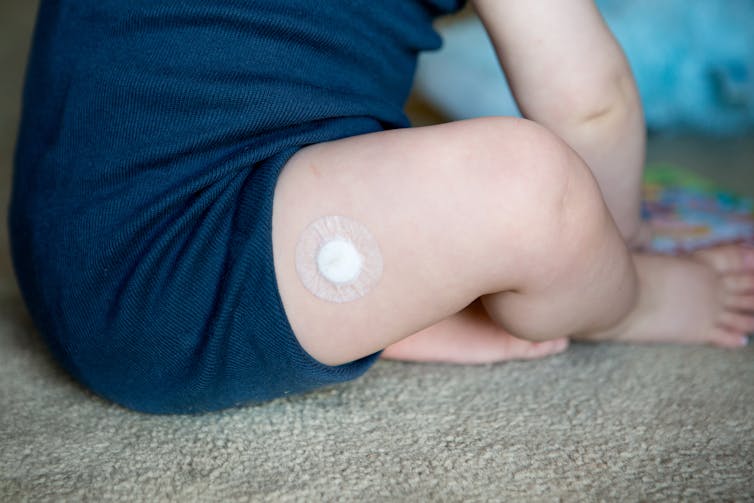
Parents and doctors alike fear meningococcal infection, which has been in the news again. Doctors never want to miss a diagnosis, as early treatment with antibiotics may be life-saving. Parents fear the disease because up to 10% of children who become infected die from the disease and its complications.
Another 40% of children will have ongoing disability from one or more complications. These include deafness, blindness, skin scarring, or surgical amputation of limbs that may be required to save the child’s life in some situations.
In other cases, children will initially be acutely unwell but then recover within a few days of starting antibiotics. Many, though, will have ongoing fatigue, forgetfulness and difficulty concentrating. For most, it’s a life-changing illness.
À lire aussi : We can expect more colds and flu as COVID restrictions lift. 5 germs to look out for
What causes it and who most at risk?
Meningococcal disease is caused by the meningococcus bacteria, also known as Neisseria meningitidis. The bacterial infection causes meningitis (infection of the lining around the brain) and/or sepsis (blood poisoning).
The highest risk of disease is in children under four years, and adolescents and young adults aged 15-24.

Aboriginal infants and young people are at higher risk of meningococcal disease than non-Indigenous children.
What are the symptoms?
Young infants who become unwell with this infection usually develop symptoms such as a fever, irritability, vomiting and poor feeding.
Young people who develop the infection may complain of a headache, neck stiffness, fever, vomiting or feeling generally tired and unwell with “flu-like” symptoms.
Unfortunately, these symptoms are fairly general and occur with many other infections, making this disease hard to diagnose. This may result in delayed diagnosis and treatment.
A more unusual symptom children or young people may experience is feeling they have cold hands and feet.
The classic dark red-purple rash associated with the infection is often a later sign of the disease. Ideally, antibiotic treatment should be started before the rash appears, to combat the infection as early as possible.
À lire aussi : Explainer: what's meningococcal meningitis and what are the signs?
How does it spread?
The meningococcus bacteria usually enter the bloodstream through the throat.
The bacteria live quite happily in the throat of around 10% of the population, without causing any symptoms. Young people in particular have a higher chance of having the bacteria in their throat and passing it to each other through air droplets from coughing or through kissing.

N. meningitidis is often referred to as an “accidental pathogen” because it prefers to live at the back of the throat, with no intent to cause meningitis or sepsis. It can invade the lining of the throat during a throat infection, which disrupts the barrier in the throat and allows the bacteria to enter the bloodstream.
It may also be more likely to invade the bloodstream and multiply if the person has a problem with their immune system.
Once in the bloodstream, the bacteria multiply very quickly and the body reacts with a very robust immune response, which unfortunately can contribute to some of the complications.
The bacteria primarily damage the walls of the blood vessels in the body and the blood vessels become leaky. This results in bleeding into the skin, which causes a rash, and lack of blood supply to the limbs, resulting in breakdown of the tissues in the limb. Sometimes this requires surgical amputation of the limb or multiple limbs to save the child’s life.
What are the different types of meningococcal disease?
There are 13 different types of meningococcus, however almost all disease in humans is caused by six groups: A, B, C, W, Y and X.
Group W is associated with a higher risk of dying from the infection (around 10-15%), whereas with group B there is a lower risk of dying (around 5-10%).
In Australia, group B causes the highest number, however there are significant differences between different states. Most cases in temperate climates occur in winter and early spring. Viral infections, in particular influenza, increase the risk of meningococcal infection.
How can you protect against it?
The best way to protect against meningococcal disease is through vaccination.
From 2003 to 2013 in Australia, there was a decrease in meningococcal disease cases, following the introduction of the free meningococcal C vaccine onto the National Immunisation Program for children aged 12 months.

A free, combined meningococcal ACWY vaccine is now available on the National Immunisation Program for all children at 12 months of age (this replaced the meningococcal C vaccine) and for adolescents aged 14-16 years through a school-based program from April 2019.
À lire aussi : Health Check: which vaccinations should I get as an adult?
A meningococcal B vaccine has been more difficult to produce and requires a different vaccine manufacturing approach. Two meningococcal B vaccines are available and licensed in Australia.
One of these meningococcal B vaccines is now provided on the National Immunisation Program for Aboriginal and Torres Strait Islander infants due to their higher risk of meningococcal B than non-Indigenous infants.
In South Australia, where historically most cases have been caused by group B, the meningococcal B vaccine is provided free through a state-funded program for infants from six weeks of age and for Year 10 students through the school immunisation program.
This followed a large study I led in South Australia of 35,000 senior school students across SA. It showed the meningococcal B vaccine was highly effective in preventing meningococcal B disease but not in reducing the number of young people carrying the disease-causing bacteria in their throat. So the vaccine needs to be given to age groups at highest risk of disease rather than expecting a herd immunity effect by reducing the number of young people carrying the disease causing bacteria in their throats.
In other states, the meningococcal B vaccine can be purchased for around A$120-$140 per dose and is provided through a script from a GP.
Helen Marshall receives funding from the National Health and Medical Research Council. Her institution receives funding from GSK, Sanofi-Pasteur and Pfizer for clinical vaccine trials of which Helen Marshall is an investigator. The herd immunity study in South Australia was sponsored by The University of Adelaide and funded by GSK.
This article was originally published on The Conversation. Read the original article.







